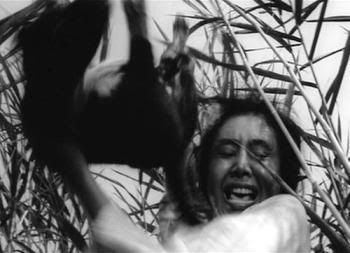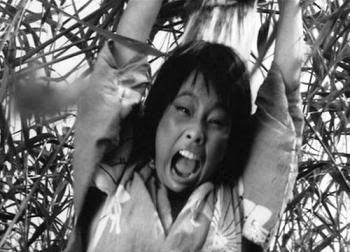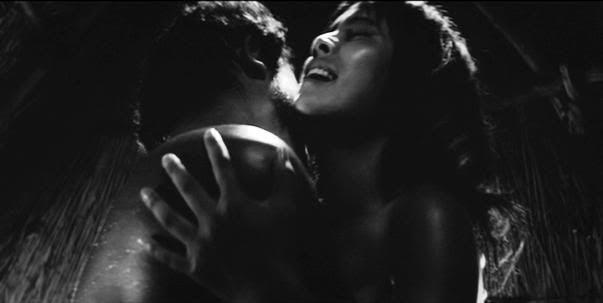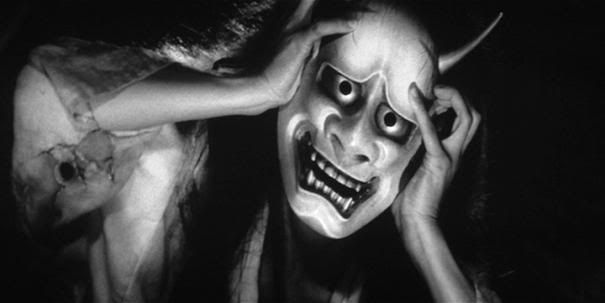 Surely a front cover like that would tempt anyone, right? Well, it tempted me anyhowz.
Surely a front cover like that would tempt anyone, right? Well, it tempted me anyhowz.Onibaba isn’t quite the terrifying frightfest that I expected. While it certainly has its fair share of unbridled horror moments, the film struck me more as an atmospheric mood piece characterised by its entrancing-but-unsettling imagery. The dominant forces are the primal concerns of survival, sex and death. To this end, Shindô situates the action in a bygone era of Japanese history where these simplistic interests can feasibly serve as the characters’ main focuses. He also makes us aware of the period’s discords, which he uses to weave in a critique of war and additionally, to justify the characters’ more repugnant qualities: the mother/daughter-in-law duo at the film’s core (referred to simply as ‘Woman’ and ‘Young Woman’) kill resting soldiers in order to sell their armour. In this way, they ironically live off death but the film makes the point that in such a turbulent environment their actions are necessary for plain survival. War has reduced them to this, although the unnerving willingness with which the characters execute their livelihoods suggests that they have allowed themselves to become totally consumed by a thirst for blood.

 The primary ‘thirst’ here isn’t a homicidal one though, it’s completely sexual. Onibaba’s English-language title is “The Hole”, a reference to a gaping black hole in the earth where murdered soldiers meet their gruesome end. Surrounded by susuki grass, it’s difficult to miss the more carnal implications of this image, with the hole itself acting as a hybridisation of all the film’s aforementioned concerns thanks to its sexual connotations and its consumption of death. The film doesn’t just infer however, it also depicts sex with an explicitness that’s refreshing given it’s context, and it continues Shindô’s theme of stripping everything down to its basest, most naturalistic instincts. The sex here is ugly, sweaty and not in the least bit arousing. Moreover, it provides the main source of conflict within the plot: the arrival of the male character, Hachi, eventually triggers the friction between the two females – he awakens the sexuality in both, but especially the daughter-in-law whose carnal desires drive her to see him despite the presence of ‘demons’ later in the film. Her pleasure invokes competition with the mother-in-law that’s dependent on her: this feral and aged woman is spurned by Hachi in the film’s closest flirtation with poignance, and thus desperately pleads with him: “I can’t kill without her!”
The primary ‘thirst’ here isn’t a homicidal one though, it’s completely sexual. Onibaba’s English-language title is “The Hole”, a reference to a gaping black hole in the earth where murdered soldiers meet their gruesome end. Surrounded by susuki grass, it’s difficult to miss the more carnal implications of this image, with the hole itself acting as a hybridisation of all the film’s aforementioned concerns thanks to its sexual connotations and its consumption of death. The film doesn’t just infer however, it also depicts sex with an explicitness that’s refreshing given it’s context, and it continues Shindô’s theme of stripping everything down to its basest, most naturalistic instincts. The sex here is ugly, sweaty and not in the least bit arousing. Moreover, it provides the main source of conflict within the plot: the arrival of the male character, Hachi, eventually triggers the friction between the two females – he awakens the sexuality in both, but especially the daughter-in-law whose carnal desires drive her to see him despite the presence of ‘demons’ later in the film. Her pleasure invokes competition with the mother-in-law that’s dependent on her: this feral and aged woman is spurned by Hachi in the film’s closest flirtation with poignance, and thus desperately pleads with him: “I can’t kill without her!” In spite of the conflict, Hachi’s introduction also leads to a temporary stalemate within the narrative, as Shindô does overtime on the underdeveloped tensions resulting from his presence. Indeed, the story as a whole is prone to fluctuations, with the introduction of the film’s notorious ‘mask’ (and thus, the entire final act) coming across as particularly contrived. Fortunately, Shindô’s visual hand is enough to counter any lulls in his tale, and its brimming with great moments: the masked soldier falling into the death pit – as filmed from inside the hole; the frequent shots of the sharp susuki grass that pierce the landscape; deft plays with light and shadows, particularly during the night sequences; even shifting to negative film stock for heightened effect; and of course, the conception of that damned mask itself – certianly one of the most bizarre props that I’ve ever come across on film. Backed up by a terrifically shrill score that punctuates the high drama, and the absence of which results in the eeriest of silences, Shindô creates nothing less than a captivating experience. For someone whose experience of Japanese cinema to date has been limited to the Holy Trinity (Kurosawa, Mizoguchi, Ozu) and second-rate horror movies, I found Onibaba a bold and exhilarating contrast to what I’m familiar with: an evocative and indelible work whose arresting images linger in the memory long after film’s end.
In spite of the conflict, Hachi’s introduction also leads to a temporary stalemate within the narrative, as Shindô does overtime on the underdeveloped tensions resulting from his presence. Indeed, the story as a whole is prone to fluctuations, with the introduction of the film’s notorious ‘mask’ (and thus, the entire final act) coming across as particularly contrived. Fortunately, Shindô’s visual hand is enough to counter any lulls in his tale, and its brimming with great moments: the masked soldier falling into the death pit – as filmed from inside the hole; the frequent shots of the sharp susuki grass that pierce the landscape; deft plays with light and shadows, particularly during the night sequences; even shifting to negative film stock for heightened effect; and of course, the conception of that damned mask itself – certianly one of the most bizarre props that I’ve ever come across on film. Backed up by a terrifically shrill score that punctuates the high drama, and the absence of which results in the eeriest of silences, Shindô creates nothing less than a captivating experience. For someone whose experience of Japanese cinema to date has been limited to the Holy Trinity (Kurosawa, Mizoguchi, Ozu) and second-rate horror movies, I found Onibaba a bold and exhilarating contrast to what I’m familiar with: an evocative and indelible work whose arresting images linger in the memory long after film’s end.
No comments:
Post a Comment